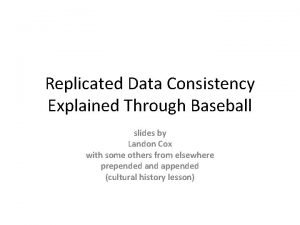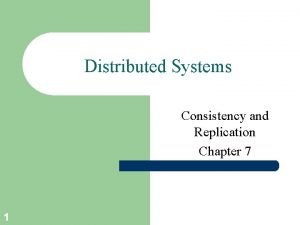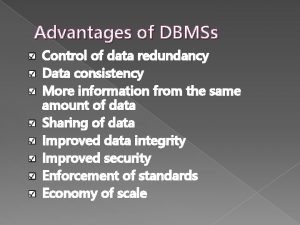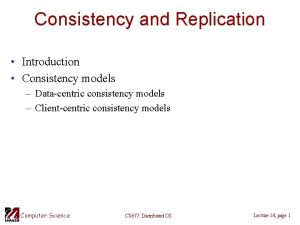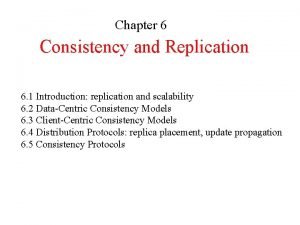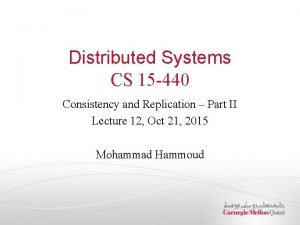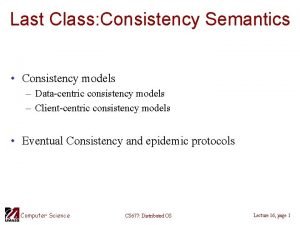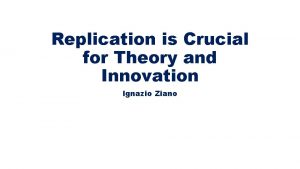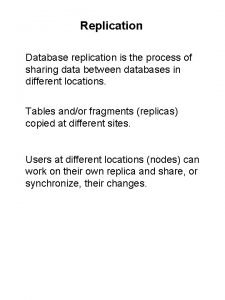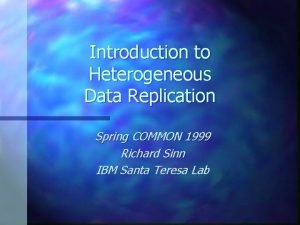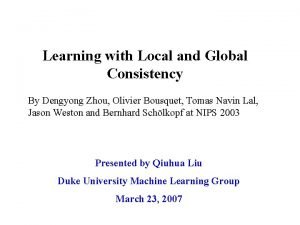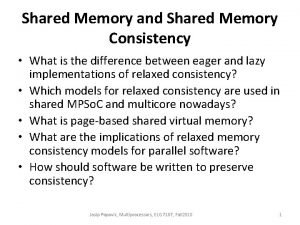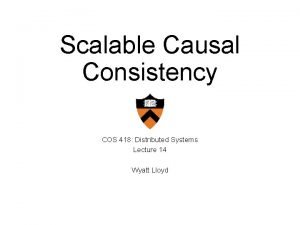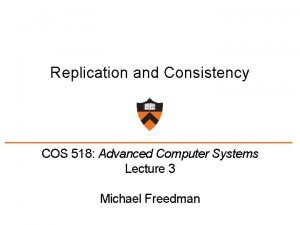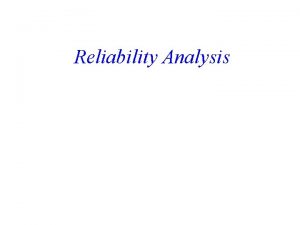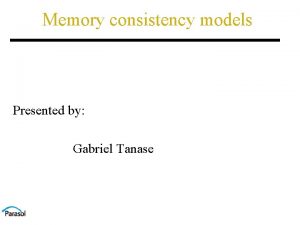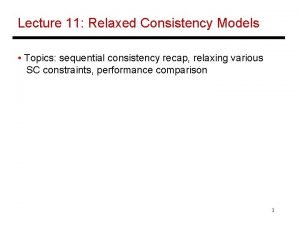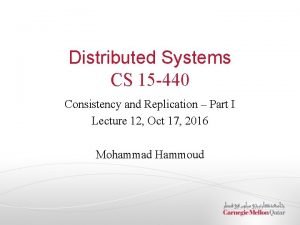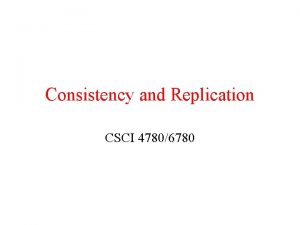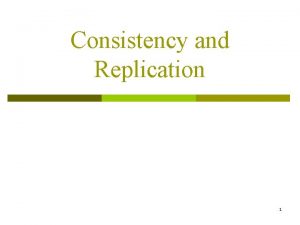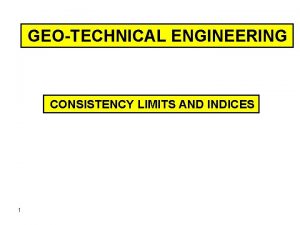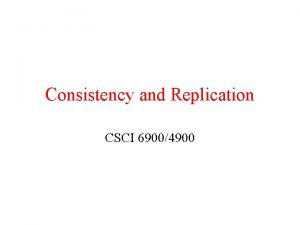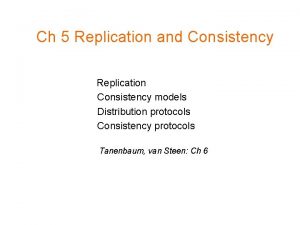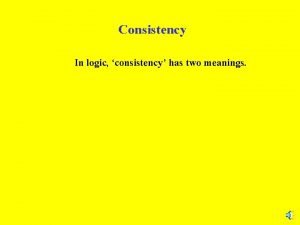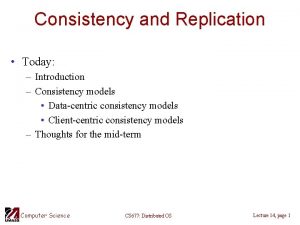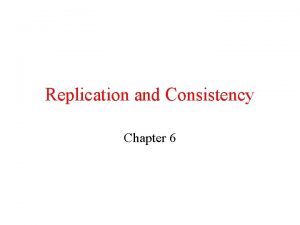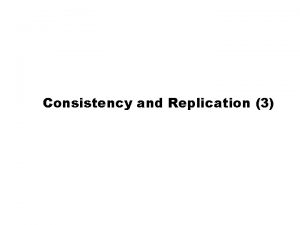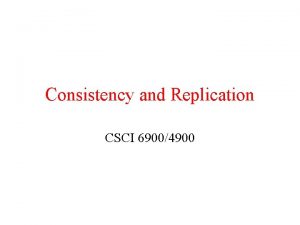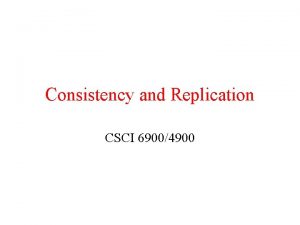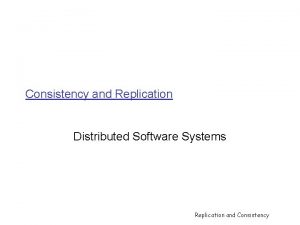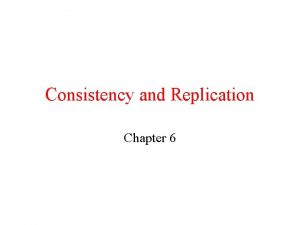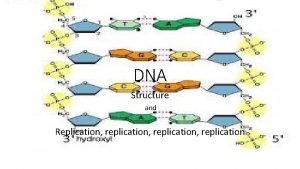Consistency and Replication Replication of data Why To














































- Slides: 46

Consistency and Replication

Replication of data Why? • To enhance reliability • To improve performance in a large scale system Replicas must be consistent • Modifications have to be carried out on all copies • Problems with network performance • It is needed to handling concurrency… Different consistency models A consistency model is a set of rules that process obeys accessing data

Object Replication How can we protect objects against multiple clients access? Synchronization. . . A distributed remote object shared by different clients.

Object Replication a) b) A remote object capable of handling concurrent invocations on its own. A remote object for which an object adapter is required to handle concurrent invocations

Object Replication Replicas need more synchronization to ensure that concurrent invocations lead to consistent results a) b) A distributed system for replication-aware distributed objects. A distributed system responsible for replica management (simpler for application developers), it ensures that concurrent invocation are passed to the replicas in the correct order

Replication and Scaling Replication and caching are widely used in scaling technique, but Keeping replicas up to date needs networks use Update needs to be atomic ( transaction) Replicas need to be synchronized (time consuming) Loose Consistency In this case copies are not always the same everywhere.

Data-Centric Consistency Models The general organization of a logical data store, physically distributed and replicated across multiple machines. Each process that can access data has its own local copy Write operations are propagated to the other copies

Strict Consistency Any read on a data item x returns a value corresponding to the result of the most recent write on x two operations in the same time interval are said to conflict if they operate on the same data and one of them is a write operation Behavior of two processes, operating on the same data item. a) A strictly consistent store. b) A store that is not strictly consistent. Strict consistency is the ideal model but it is impossible to implement in a distributed system It is based on absolute global time.

Linearizability and Sequential Consistency (1) Sequential Consistency it is a weaker consistency model than strict consistency The result of any execution is the same as if the read and write operations by all processes on the data store were executed in some sequential order and the operations of each individual process appear in this sequence in the order specified by its program All processes see the same interleaving of operations a) b) A sequentially consistent data store. A data store that is not sequentially consistent. c) No reference to the timing of the operations

Linearizability and Sequential Consistency (2) Linearizability is weaker than strict consistency but stronger than sequential consistency The result of any execution is the same as if the read and write operations by all processes on the data store were executed in some sequential order and the operations of each individual process appear in this sequence in the order specified by its program. In addition, if ts. OP 1(x) < ts. OP 2(y), then operation OP 1(x) should precede OP 2(y) in this sequence Operations receive a timestamp using a global clock, but with finite precision Process P 1 Process P 2 Process P 3 x = 1; print ( y, z); y = 1; print (x, z); z = 1; write print (x, y); read Example : three concurrently executing processes; (x, y, z) are data store items Various (90) interleaved execution sequences are possible

Linearizability and Sequential Consistency (3) x = 1; print ((y, z); y = 1; print (x, z); z = 1; print (x, y); x = 1; y = 1; print (x, z); print(y, z); z = 1; print (x, y); y = 1; z = 1; print (x, y); print (x, z); x = 1; print (y, z); y = 1; x = 1; z = 1; print (x, z); print (y, z); print (x, y); Prints: 001011 Prints: 101011 Prints: 010111 Prints: 111111 Signature: 001011 (a) Signature: 101011 (b) Signature: 110101 (c) Signature: 111111 (d) Not all signature pattern are allowed : 000000 not permitted, 001001 not permitted Constraints: • Program order must be maintained • Data coherence must be respected Data coherence : any read must return the most recently written value of the data (relatively to the single data item, without regard to other data)

Causal Consistency (1) When there is a read followed by a write, the two events are potentially causally related Operation not causally related are said concurrent Necessary condition: Writes that are potentially causally related must be seen by all processes in the same order. Concurrent writes may be seen in a different order on different machines.

Causal Consistency (2) This sequence is allowed with a causally-consistent store, but not with sequentially or strictly consistent store. Note that the writes W 2(x)b and W 1(x)c are concurrent Causal consistency requires keeping tracks of which processes have seen which writes

Causal Consistency (3) a) b) A violation of a casually-consistent store. W 2(x)b may be related to W 1(x)a A correct sequence of events in a casually-consistent store. W 1(x)a and W 2(x)b are concurrent

Causal Consistency (1) When there is a read followed by a write, the two events are potentially causally related Operation not causally related are said concurrent Necessary condition: Writes that are potentially causally related must be seen by all processes in the same order. Concurrent writes may be seen in a different order on different machines.

Causal Consistency (2) This sequence is allowed with a causally-consistent store, but not with sequentially or strictly consistent store. Note that the writes W 2(x)b and W 1(x)c are concurrent Causal consistency requires keeping tracks of which processes have seen which writes

Causal Consistency (3) a) b) A violation of a casually-consistent store. W 2(x)b may be related to W 1(x)a A correct sequence of events in a casually-consistent store. W 1(x)a and W 2(x)b are concurrent

FIFO Consistency (1) Relaxing consistency requirements we drop causality Necessary Condition: Writes done by a single process are seen by all other processes in the order in which they were issued, but writes from different processes may be seen in a different order by different processes. All writes generated by different processes are considered concurrent It is easy to implement

FIFO Consistency (2) A valid sequence of events of FIFO consistency. It is not valid for causal consistency

FIFO Consistency (3) Process P 1 Process P 2 Process P 3 x = 1; print ( y, z); y = 1; print (x, z); z = 1; print (x, y); x = 1; print (y, z); y = 1; print(x, z); z = 1; print (x, y); x = 1; y = 1; print(x, z); print ( y, z); z = 1; print (x, y); y = 1; print (x, z); z = 1; print (x, y); x = 1; print (y, z); Prints: 00 Prints: 10 Prints: 01 (a) (b) write read (c) The statements in bold are the ones that generate the output shown. Their concatenated output is 001001, that is incompatible with sequential consistency

FIFO Consistency (4) Different processes can see the operations in different order Process P 1 Process P 2 x = 1; if (y == 0) kill (P 2); y = 1; if (x == 0) kill (P 1); The result of this two concurrent processes can be also that both processes are killed.

Weak Consistency We can release the requirements of writes within the same process seen in order everywhere introducing a synchronization variable. A synchronization operation synchronize all local copies of the data store. Properties of weak consistency: • Accesses to synchronization variables associated with a data store are sequentially consistent • No operation on a synchronization variable is allowed to be performed until all previous writes have been completed everywhere • No read or write operation on data items are allowed to be performed until all previous operations to synchronization variables have been performed. It forces consistency on a group of operations, not on individual write and read It limits the time when consistency holds, not the form of consistency.

Weak Consistency a) b) A valid sequence of events for weak consistency. An invalid sequence for weak consistency.

Release Consistency If it is possible to know the difference between entering a critical region or leaving it, a more efficient implementation might be possible. To do that, two kinds of synchronization variables are needed. Release consistency : acquire operation to tell that a critical region is being entered; release operation when a critical region is to be exited A valid event sequence for release consistency. Shared data kept consistent are called protected

Release Consistency Rules: • Before a read or write operation on shared data is performed, all previous acquires done by the process must have completed successfully. • Before a release is allowed to be performed, all previous reads and writes by the process must have completed • Accesses to synchronization variables are FIFO consistent (sequential consistency is not required). Explicit acquire and release calls are required

Entry Consistency Many synchronization variables associated with each shared data Conditions: • An acquire access of a synchronization variable is not allowed to perform with respect to a process until all updates to the guarded shared data have been performed with respect to that process. • Before an exclusive mode access to a synchronization variable by a process is allowed to perform with respect to that process, no other process may hold the synchronization variable, not even in nonexclusive mode. • After an exclusive mode access to a synchronization variable has been performed, any other process's next nonexclusive mode access to that synchronization variable may not be performed until it has performed with respect to that variable's owner.

Entry Consistency (1) A valid event sequence for entry consistency. Lock are associated with each data item

Summary of Consistency Models Consistency Description Strict Absolute time ordering of all shared accesses matters. Linearizability All processes must see all shared accesses in the same order. Accesses are furthermore ordered according to a (nonunique) global timestamp Sequential All processes see all shared accesses in the same order. Accesses are not ordered in time Causal All processes see causally-related shared accesses in the same order. FIFO All processes see writes from each other in the order they were used. Writes from different processes may not always be seen in that order (a) Consistency Description Weak Shared data can be counted on to be consistent only after a synchronization is done Release Shared data are made consistent when a critical region is exited Entry Shared data pertaining to a critical region are made consistent when a critical region is entered. (b) a) b) Consistency models not using synchronization operations. Models with synchronization operations.

Client Centric Consistency In many cases concurrency appears only in restricted form. In many applications most processes only read data Some degrees of inconsistency can be tolerate In some cases if for a long time no update takes place all replicas gradually become consistent Eventual consistency

Eventual Consistency eventual consistency for replicated data is fine if clients always access the same replica Client centric consistency provides consistency guarantees for a single client with respect to the data stored by that client A mobile user accessing different replicas of a distributed database has problems with eventual consistency.

Client centric models Clients access distributed data store using, generally, the local copy. Updates are eventually propagated to other copies. • Monotonic read If a process reads the value of a data item x, any successive read operation on x by that process will always return that same value or a more recent value • Monotonic write A write operation by a process on a data item x is completed before any successive write operation on x by the same process • Read your writes The effect of a write operation by a process on a data item x will always be seen by a successive read operation on x by the same process • Writes follow reads A write operation by a process on a data item x following a previous read operation on x by the same process, is guaranteed to take place on the same or more recent values of x that was read

Distribution Protocols Replica Placement Where, when, by whom copies of data are to be placed? The logical organization of different kinds of copies of a data store into three concentric rings.

Server-Initiated Replicas Push cache Web case. Counting access requests from different clients.

Update propagation What is to be propagated? • Propagate only a notification of an update (Invalidation protocols) - R/W ratio: low • Transfer data from one copy to another - R/W ratio: high • Propagate the update operation to other copies (Active replication)

Pull versus Push Protocols How is it to be propagated? • Push (or server) based protocols update are propagated to other replicas without request when a high consistency degree is needed I. e. Permanent to server initiated replicas • Pull (or client) based protocols update are propagated to other replicas on request I. e. Web cache

Pull versus Push Protocols Issue Push-based Pull-based State at server List of client replicas and caches None Messages sent Update (and possibly fetch update later for invalidation protocols) Poll and update Response time at client Immediate (or fetch-update time) Fetch-update time Hybrid propagation : lease (in a lease servers push updates with expiration time) What kind of communication can be used? • Unicast ( pull based approach) • Multicast (push based approach)

Epidemic propagation It is used with eventual consistency and the main goal is to propagate updates with a few messages. The infective server holds an update, the susceptible server will to be updated Anti-entropy model: Three approaches: • P pushes its updates to Q • Q pulls new updates from P • P and Q send their updates each other Gossiping

Consistency Protocols Primary-based protocols Each data item x in the data store has an associated primary, which is responsible for coordinating write operations on x Replicated write protocols Write operations can be carried out at multiple replicas instead of only one Cache-coherence protocols Controlled by clients instead of servers

Remote-Write Protocols Primary-based remote-write protocol with a fixed server to which all read and write operations are forwarded. Data can be distributed, but they are not replicated (really simple!).

Remote-Write Protocols The principle of primary-backup protocol (time consuming). It implements sequential consistency if done as a blocking operation.

Local-Write Protocols Primary-based local-write protocol in which a single copy is migrated between processes (fully distributed non-replicated version of the data store). Location information is the main problem in a widely distributed data store.

Local-Write Protocols Primary-backup protocol in which the primary migrates to the process wanting to perform an update. Write operations performed locally. Useful for a disconnected mobile computer

Replicated Write Protocols Active Replication Each replica has an associated process that carries out update operations. Updates are propagated by means of the write operation that causes the update Upgrades need to maintain operations order (Lamport timestamps or coordinator); Problems of replicated invocations: multiple invocations of the same object can produce errors

Active Replication a) b) Forwarding an invocation request from a replicated object (via unique ID). Returning a reply to a replicated object from a replicated object.

Replicated Write Protocols Quorum-Based Protocols clients request and acquire permission of multiple server before accessing data NR +N W > N /2 Three examples of the voting algorithm: a) A correct choice of read and write set b) A choice that may lead to write-write conflicts ( NW = N/2) c) A correct choice, known as ROWA (read one, write all)

Cache Coherence Protocols Caching can be analyzed according to different parameters Coherence detection strategy (when) • verification of consistency before cached data accessed • no verification : data are assumed consistent • verification after cached data used Coherence enforcement strategy (how) • no cached shared data (only at servers) • servers send invalidation messages to all caches • servers propagate updates Write-through cache • clients modify cached data and forward updates to servers
 Bitcoin
Bitcoin Distributed data store
Distributed data store Hey hey bye bye
Hey hey bye bye Bioflix activity dna replication lagging strand synthesis
Bioflix activity dna replication lagging strand synthesis Data redundancy and consistency
Data redundancy and consistency Inside planet earth video worksheet answers
Inside planet earth video worksheet answers Explain data centric consistency model
Explain data centric consistency model Explain data centric consistency model
Explain data centric consistency model Continuous consistency in distributed system
Continuous consistency in distributed system Consistency in science
Consistency in science Client-centric consistency models
Client-centric consistency models Don't ask why why why
Don't ask why why why Why is “replication key” psychology experiments?
Why is “replication key” psychology experiments? Why is dna replication considered semiconservative
Why is dna replication considered semiconservative Data replication process
Data replication process Azure storage replication
Azure storage replication Heterogeneous data replication
Heterogeneous data replication Denny wong slides
Denny wong slides Oracle advanced replication
Oracle advanced replication Dengyong zhou
Dengyong zhou Feel and appearance of a surface
Feel and appearance of a surface Liquid limit flow curve
Liquid limit flow curve Vision eloquence and consistency
Vision eloquence and consistency Verb consistency
Verb consistency Will vs shall
Will vs shall What consistency is the brain
What consistency is the brain Consistency is the last refuge of the unimaginative
Consistency is the last refuge of the unimaginative Shared memory consistency models a tutorial
Shared memory consistency models a tutorial Memory consistency models in distributed systems
Memory consistency models in distributed systems Setting product strategy
Setting product strategy Causal consistency
Causal consistency Causal consistency
Causal consistency Cronbach alpha reliability
Cronbach alpha reliability Sequential consistency
Sequential consistency Relaxed consistency
Relaxed consistency Consistency is an underappreciated
Consistency is an underappreciated Internal reliability
Internal reliability Dyphagia
Dyphagia Continuous consistency in distributed system
Continuous consistency in distributed system Consistent pronoun
Consistent pronoun Strict consistency
Strict consistency Strict consistency
Strict consistency Internal consistency compensation system
Internal consistency compensation system Goods-to-services continuum
Goods-to-services continuum Consistency limits in geotechnical engineering
Consistency limits in geotechnical engineering Demotivational poster consistency
Demotivational poster consistency Verb consistency
Verb consistency
